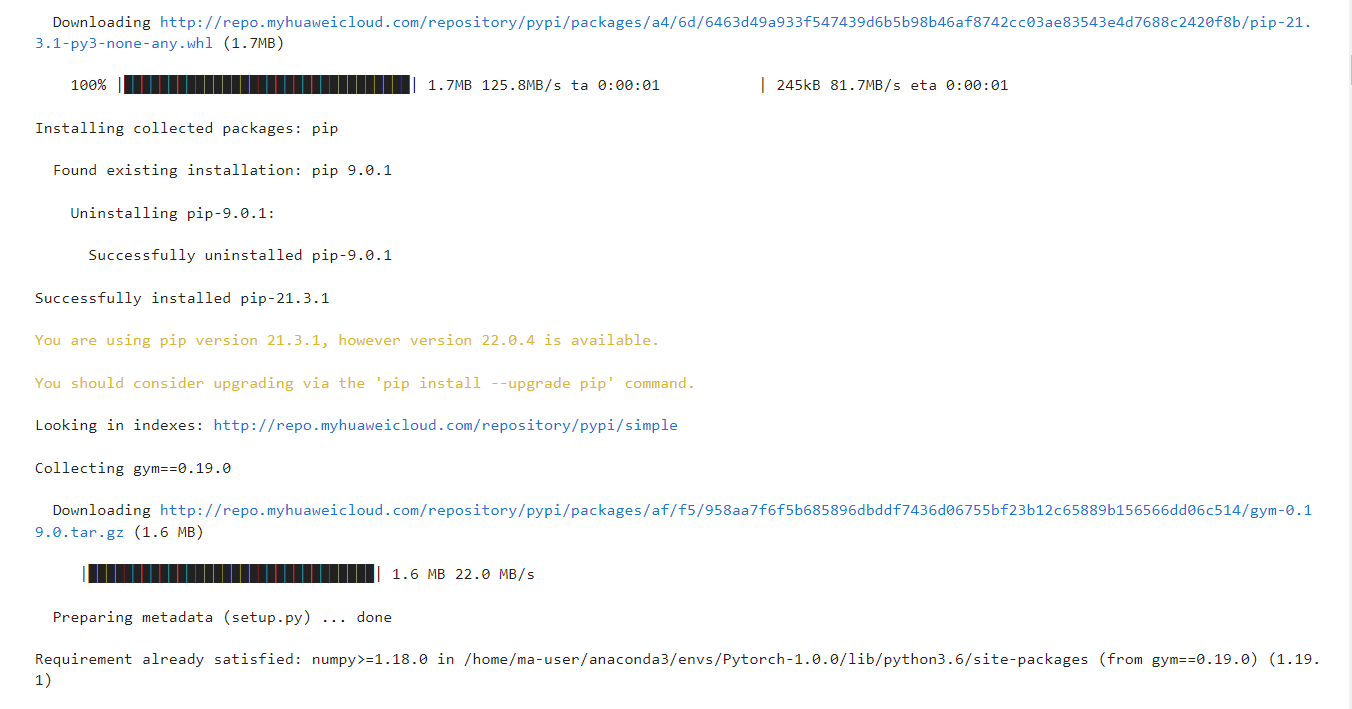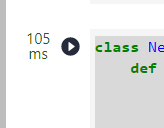- 1python数据清洗的方法有哪些_7步搞定数据清洗-Python数据清洗指南
- 2react-native 插件汇总_react native 城市插件
- 3阿里大模型又开源!能读图会识物,基于通义千问7B打造,可商用
- 4HUAWEI HiCar让华为手机用户中的宝马车主Hi起来!_爱乐士宝马车机
- 5Android布局之屏幕自适应_android自定义布局如何能不随系统显示大小而变化
- 6论文ai写作生成器论文论文(ai写作网站免费)
- 7不满足当 ChatGPT “接口侠”?轻松可视化 Fine-tuning 训练你的模型!_dify ops
- 8五、NLP聊天语料处理_nlp 分析聊天记录
- 9Linux-一篇文章,速通Hadoop集群之伪分布式,完全分布式,高可用搭建(附zookeeper,jdk介绍与安装)。
- 10Mac电脑mds_store进程占用cpu过高_mdsstores占用cpu
基于云ModelArts的PPO算法玩“超级马里奥兄弟”【华为云至简致远】_华为云使用ppo
赞
踩
【摘要】 一.前言我们利用PPO算法来玩“Super Mario Bros”(超级马里奥兄弟)。目前来看,对于绝大部分关卡,智能体都可以在1500个episode内学会过关。 二.PPO算法的基本结构PPO算法有两种主要形式:PPO-Penalty和PPO-Clip(PPO2)。在这里,我们讨论PPO-Clip(OpenAI使用的主要形式)。 PPO的主要特点如下:PPO属于on-policy算法P...
一.前言
我们利用PPO算法来玩“Super Mario Bros”(超级马里奥兄弟)。目前来看,对于绝大部分关卡,智能体都可以在1500个episode内学会过关。
二.PPO算法的基本结构
PPO算法有两种主要形式:PPO-Penalty和PPO-Clip(PPO2)。在这里,我们讨论PPO-Clip(OpenAI使用的主要形式)。 PPO的主要特点如下:
PPO属于on-policy算法
PPO同时适用于离散和连续的动作空间
损失函数 PPO-Clip算法最精髓的地方就是加入了一项比例用以描绘新老策略的差异,通过超参数ϵ限制策略的更新步长:

更新策略:
探索策略 PPO采用随机探索策略。
优势函数 表示在状态s下采取动作a,相较于其他动作有多少优势,如果>0,则当前动作比平均动作好,反之,则差
算法主要流程大致如下:

三.进入实操
我们需要先进入我们的华为云实例网址,使用PPO算法玩超级马里奥兄弟
我们需要登录华为云账号,点击订阅这个实例,然后才能点击Run in ModelArts,进入 JupyterLab 页面。

我们进入页面,先需要等待,等待30s之后弹出如下页面,让我们选择合适的运行环境,我们选择免费的就好,点击切换规格。
等待切换规格完成:等待初始化完成…
如下图,等待初始化完成。一切就绪
3.1 程序初始化
安装基础依赖
- !pip install -U pip
- !pip install gym==0.19.0
- !pip install tqdm==4.48.0
- !pip install nes-py==8.1.0
- !pip install gym-super-mario-bros==7.3.2

3.2 导入相关的库
- import os
- import shutil
- import subprocess as sp
- from collections import deque
-
- import numpy as np
- import torch
- import torch.nn as nn
- import torch.nn.functional as F
- import torch.multiprocessing as _mp
- from torch.distributions import Categorical
- import torch.multiprocessing as mp
- from nes_py.wrappers import JoypadSpace
- import gym_super_mario_bros
- from gym.spaces import Box
- from gym import Wrapper
- from gym_super_mario_bros.actions import SIMPLE_MOVEMENT, COMPLEX_MOVEMENT, RIGHT_ONLY
- import cv2
- import matplotlib.pyplot as plt
- from IPython import display
-
- import moxing as mox


3.3训练参数初始化
- opt={
- "world": 1, # 可选大关:1,2,3,4,5,6,7,8
- "stage": 1, # 可选小关:1,2,3,4
- "action_type": "simple", # 动作类别:"simple","right_only", "complex"
- 'lr': 1e-4, # 建议学习率:1e-3,1e-4, 1e-5,7e-5
- 'gamma': 0.9, # 奖励折扣
- 'tau': 1.0, # GAE参数
- 'beta': 0.01, # 熵系数
- 'epsilon': 0.2, # PPO的Clip系数
- 'batch_size': 16, # 经验回放的batch_size
- 'max_episode':10, # 最大训练局数
- 'num_epochs': 10, # 每条经验回放次数
- "num_local_steps": 512, # 每局的最大步数
- "num_processes": 8, # 训练进程数,一般等于训练机核心数
- "save_interval": 5, # 每{}局保存一次模型
- "log_path": "./log", # 日志保存路径
- "saved_path": "./model", # 训练模型保存路径
- "pretrain_model": True, # 是否加载预训练模型,目前只提供1-1关卡的预训练模型,其他需要从零开始训练
- "episode":5
- }

3.4 创建环境
- # 创建环境
- def create_train_env(world, stage, actions, output_path=None):
- # 创建基础环境
- env = gym_super_mario_bros.make("SuperMarioBros-{}-{}-v0".format(world, stage))
-
- env = JoypadSpace(env, actions)
- # 对环境自定义
- env = CustomReward(env, world, stage, monitor=None)
- env = CustomSkipFrame(env)
- return env
- # 对原始环境进行修改,以获得更好的训练效果
- class CustomReward(Wrapper):
- def __init__(self, env=None, world=None, stage=None, monitor=None):
- super(CustomReward, self).__init__(env)
- self.observation_space = Box(low=0, high=255, shape=(1, 84, 84))
- self.curr_score = 0
- self.current_x = 40
- self.world = world
- self.stage = stage
- if monitor:
- self.monitor = monitor
- else:
- self.monitor = None
-
- def step(self, action):
- state, reward, done, info = self.env.step(action)
- if self.monitor:
- self.monitor.record(state)
- state = process_frame(state)
- reward += (info["score"] - self.curr_score) / 40.
- self.curr_score = info["score"]
- if done:
- if info["flag_get"]:
- reward += 50
- else:
- reward -= 50
- if self.world == 7 and self.stage == 4:
- if (506 <= info["x_pos"] <= 832 and info["y_pos"] > 127) or (
- 832 < info["x_pos"] <= 1064 and info["y_pos"] < 80) or (
- 1113 < info["x_pos"] <= 1464 and info["y_pos"] < 191) or (
- 1579 < info["x_pos"] <= 1943 and info["y_pos"] < 191) or (
- 1946 < info["x_pos"] <= 1964 and info["y_pos"] >= 191) or (
- 1984 < info["x_pos"] <= 2060 and (info["y_pos"] >= 191 or info["y_pos"] < 127)) or (
- 2114 < info["x_pos"] < 2440 and info["y_pos"] < 191) or info["x_pos"] < self.current_x - 500:
- reward -= 50
- done = True
- if self.world == 4 and self.stage == 4:
- if (info["x_pos"] <= 1500 and info["y_pos"] < 127) or (
- 1588 <= info["x_pos"] < 2380 and info["y_pos"] >= 127):
- reward = -50
- done = True
-
- self.current_x = info["x_pos"]
- return state, reward / 10., done, info
-
- def reset(self):
- self.curr_score = 0
- self.current_x = 40
- return process_frame(self.env.reset())
- class MultipleEnvironments:
- def __init__(self, world, stage, action_type, num_envs, output_path=None):
- self.agent_conns, self.env_conns = zip(*[mp.Pipe() for _ in range(num_envs)])
- if action_type == "right_only":
- actions = RIGHT_ONLY
- elif action_type == "simple":
- actions = SIMPLE_MOVEMENT
- else:
- actions = COMPLEX_MOVEMENT
- self.envs = [create_train_env(world, stage, actions, output_path=output_path) for _ in range(num_envs)]
- self.num_states = self.envs[0].observation_space.shape[0]
- self.num_actions = len(actions)
- for index in range(num_envs):
- process = mp.Process(target=self.run, args=(index,))
- process.start()
- self.env_conns[index].close()
-
- def run(self, index):
- self.agent_conns[index].close()
- while True:
- request, action = self.env_conns[index].recv()
- if request == "step":
- self.env_conns[index].send(self.envs[index].step(action.item()))
- elif request == "reset":
- self.env_conns[index].send(self.envs[index].reset())
- else:
- raise NotImplementedError
- def process_frame(frame):
- if frame is not None:
- frame = cv2.cvtColor(frame, cv2.COLOR_RGB2GRAY)
- frame = cv2.resize(frame, (84, 84))[None, :, :] / 255.
- return frame
- else:
- return np.zeros((1, 84, 84))
- class CustomSkipFrame(Wrapper):
- def __init__(self, env, skip=4):
- super(CustomSkipFrame, self).__init__(env)
- self.observation_space = Box(low=0, high=255, shape=(skip, 84, 84))
- self.skip = skip
- self.states = np.zeros((skip, 84, 84), dtype=np.float32)
-
- def step(self, action):
- total_reward = 0
- last_states = []
- for i in range(self.skip):
- state, reward, done, info = self.env.step(action)
- total_reward += reward
- if i >= self.skip / 2:
- last_states.append(state)
- if done:
- self.reset()
- return self.states[None, :, :, :].astype(np.float32), total_reward, done, info
- max_state = np.max(np.concatenate(last_states, 0), 0)
- self.states[:-1] = self.states[1:]
- self.states[-1] = max_state
- return self.states[None, :, :, :].astype(np.float32), total_reward, done, info
-
- def reset(self):
- state = self.env.reset()
- self.states = np.concatenate([state for _ in range(self.skip)], 0)
- return self.states[None, :, :, :].astype(np.float32)

3.5定义神经网络
- class Net(nn.Module):
- def __init__(self, num_inputs, num_actions):
- super(Net, self).__init__()
- self.conv1 = nn.Conv2d(num_inputs, 32, 3, stride=2, padding=1)
- self.conv2 = nn.Conv2d(32, 32, 3, stride=2, padding=1)
- self.conv3 = nn.Conv2d(32, 32, 3, stride=2, padding=1)
- self.conv4 = nn.Conv2d(32, 32, 3, stride=2, padding=1)
- self.linear = nn.Linear(32 * 6 * 6, 512)
- self.critic_linear = nn.Linear(512, 1)
- self.actor_linear = nn.Linear(512, num_actions)
- self._initialize_weights()
-
- def _initialize_weights(self):
- for module in self.modules():
- if isinstance(module, nn.Conv2d) or isinstance(module, nn.Linear):
- nn.init.orthogonal_(module.weight, nn.init.calculate_gain('relu'))
- nn.init.constant_(module.bias, 0)
-
- def forward(self, x):
- x = F.relu(self.conv1(x))
- x = F.relu(self.conv2(x))
- x = F.relu(self.conv3(x))
- x = F.relu(self.conv4(x))
- x = self.linear(x.view(x.size(0), -1))
- return self.actor_linear(x), self.critic_linear(x)


3.6 定义PPO算法
- def evaluation(opt, global_model, num_states, num_actions,curr_episode):
- print('start evalution !')
- torch.manual_seed(123)
- if opt['action_type'] == "right":
- actions = RIGHT_ONLY
- elif opt['action_type'] == "simple":
- actions = SIMPLE_MOVEMENT
- else:
- actions = COMPLEX_MOVEMENT
- env = create_train_env(opt['world'], opt['stage'], actions)
- local_model = Net(num_states, num_actions)
- if torch.cuda.is_available():
- local_model.cuda()
- local_model.eval()
- state = torch.from_numpy(env.reset())
- if torch.cuda.is_available():
- state = state.cuda()
-
- plt.figure(figsize=(10,10))
- img = plt.imshow(env.render(mode='rgb_array'))
-
- done=False
- local_model.load_state_dict(global_model.state_dict()) #加载网络参数\
-
- while not done:
- if torch.cuda.is_available():
- state = state.cuda()
- logits, value = local_model(state)
- policy = F.softmax(logits, dim=1)
- action = torch.argmax(policy).item()
- state, reward, done, info = env.step(action)
- state = torch.from_numpy(state)
-
- img.set_data(env.render(mode='rgb_array')) # just update the data
- display.display(plt.gcf())
- display.clear_output(wait=True)
-
- if info["flag_get"]:
- print("flag getted in episode:{}!".format(curr_episode))
- torch.save(local_model.state_dict(),
- "{}/ppo_super_mario_bros_{}_{}_{}".format(opt['saved_path'], opt['world'], opt['stage'],curr_episode))
- opt.update({'episode':curr_episode})
- env.close()
- return True
- return False
- def train(opt):
- #判断cuda是否可用
- if torch.cuda.is_available():
- torch.cuda.manual_seed(123)
- else:
- torch.manual_seed(123)
- if os.path.isdir(opt['log_path']):
- shutil.rmtree(opt['log_path'])
-
- os.makedirs(opt['log_path'])
- if not os.path.isdir(opt['saved_path']):
- os.makedirs(opt['saved_path'])
- mp = _mp.get_context("spawn")
- #创建环境
- envs = MultipleEnvironments(opt['world'], opt['stage'], opt['action_type'], opt['num_processes'])
- #创建模型
- model = Net(envs.num_states, envs.num_actions)
- if opt['pretrain_model']:
- print('加载预训练模型')
- if not os.path.exists("ppo_super_mario_bros_1_1_0"):
- mox.file.copy_parallel(
- "obs://modelarts-labs-bj4/course/modelarts/zjc_team/reinforcement_learning/ppo_mario/ppo_super_mario_bros_1_1_0",
- "ppo_super_mario_bros_1_1_0")
- if torch.cuda.is_available():
- model.load_state_dict(torch.load("ppo_super_mario_bros_1_1_0"))
- model.cuda()
- else:
- model.load_state_dict(torch.load("ppo_super_mario_bros_1_1_0",torch.device('cpu')))
- else:
- model.cuda()
- model.share_memory()
- optimizer = torch.optim.Adam(model.parameters(), lr=opt['lr'])
- #环境重置
- [agent_conn.send(("reset", None)) for agent_conn in envs.agent_conns]
- #接收当前状态
- curr_states = [agent_conn.recv() for agent_conn in envs.agent_conns]
- curr_states = torch.from_numpy(np.concatenate(curr_states, 0))
- if torch.cuda.is_available():
- curr_states = curr_states.cuda()
- curr_episode = 0
- #在最大局数内训练
- while curr_episode<opt['max_episode']:
- if curr_episode % opt['save_interval'] == 0 and curr_episode > 0:
- torch.save(model.state_dict(),
- "{}/ppo_super_mario_bros_{}_{}_{}".format(opt['saved_path'], opt['world'], opt['stage'], curr_episode))
- curr_episode += 1
- old_log_policies = []
- actions = []
- values = []
- states = []
- rewards = []
- dones = []
- #一局内最大步数
- for _ in range(opt['num_local_steps']):
- states.append(curr_states)
- logits, value = model(curr_states)
- values.append(value.squeeze())
- policy = F.softmax(logits, dim=1)
- old_m = Categorical(policy)
- action = old_m.sample()
- actions.append(action)
- old_log_policy = old_m.log_prob(action)
- old_log_policies.append(old_log_policy)
- #执行action
- if torch.cuda.is_available():
- [agent_conn.send(("step", act)) for agent_conn, act in zip(envs.agent_conns, action.cpu())]
- else:
- [agent_conn.send(("step", act)) for agent_conn, act in zip(envs.agent_conns, action)]
- state, reward, done, info = zip(*[agent_conn.recv() for agent_conn in envs.agent_conns])
- state = torch.from_numpy(np.concatenate(state, 0))
- if torch.cuda.is_available():
- state = state.cuda()
- reward = torch.cuda.FloatTensor(reward)
- done = torch.cuda.FloatTensor(done)
- else:
- reward = torch.FloatTensor(reward)
- done = torch.FloatTensor(done)
- rewards.append(reward)
- dones.append(done)
- curr_states = state
-
- _, next_value, = model(curr_states)
- next_value = next_value.squeeze()
- old_log_policies = torch.cat(old_log_policies).detach()
- actions = torch.cat(actions)
- values = torch.cat(values).detach()
- states = torch.cat(states)
- gae = 0
- R = []
- #gae计算
- for value, reward, done in list(zip(values, rewards, dones))[::-1]:
- gae = gae * opt['gamma'] * opt['tau']
- gae = gae + reward + opt['gamma'] * next_value.detach() * (1 - done) - value.detach()
- next_value = value
- R.append(gae + value)
- R = R[::-1]
- R = torch.cat(R).detach()
- advantages = R - values
- #策略更新
- for i in range(opt['num_epochs']):
- indice = torch.randperm(opt['num_local_steps'] * opt['num_processes'])
- for j in range(opt['batch_size']):
- batch_indices = indice[
- int(j * (opt['num_local_steps'] * opt['num_processes'] / opt['batch_size'])): int((j + 1) * (
- opt['num_local_steps'] * opt['num_processes'] / opt['batch_size']))]
- logits, value = model(states[batch_indices])
- new_policy = F.softmax(logits, dim=1)
- new_m = Categorical(new_policy)
- new_log_policy = new_m.log_prob(actions[batch_indices])
- ratio = torch.exp(new_log_policy - old_log_policies[batch_indices])
- actor_loss = -torch.mean(torch.min(ratio * advantages[batch_indices],
- torch.clamp(ratio, 1.0 - opt['epsilon'], 1.0 + opt['epsilon']) *
- advantages[
- batch_indices]))
- critic_loss = F.smooth_l1_loss(R[batch_indices], value.squeeze())
- entropy_loss = torch.mean(new_m.entropy())
- #损失函数包含三个部分:actor损失,critic损失,和动作entropy损失
- total_loss = actor_loss + critic_loss - opt['beta'] * entropy_loss
- optimizer.zero_grad()
- total_loss.backward()
- torch.nn.utils.clip_grad_norm_(model.parameters(), 0.5)
- optimizer.step()
- print("Episode: {}. Total loss: {}".format(curr_episode, total_loss))
-
- finish=False
- for i in range(opt["num_processes"]):
- if info[i]["flag_get"]:
- finish=evaluation(opt, model,envs.num_states, envs.num_actions,curr_episode)
- if finish:
- break
- if finish:
- break

3.7 训练模型
训练10 Episode,耗时约5分钟
train(opt)
这里比较费时间哈,多等待,正在训练模型中…
我这里花了2.6分钟哈,还是比较快的,如图:

3.8 使用模型推理游戏
定义推理函数
- def infer(opt):
- if torch.cuda.is_available():
- torch.cuda.manual_seed(123)
- else:
- torch.manual_seed(123)
- if opt['action_type'] == "right":
- actions = RIGHT_ONLY
- elif opt['action_type'] == "simple":
- actions = SIMPLE_MOVEMENT
- else:
- actions = COMPLEX_MOVEMENT
- env = create_train_env(opt['world'], opt['stage'], actions)
- model = Net(env.observation_space.shape[0], len(actions))
- if torch.cuda.is_available():
- model.load_state_dict(torch.load("{}/ppo_super_mario_bros_{}_{}_{}".format(opt['saved_path'],opt['world'], opt['stage'],opt['episode'])))
- model.cuda()
- else:
- model.load_state_dict(torch.load("{}/ppo_super_mario_bros_{}_{}_{}".format(opt['saved_path'], opt['world'], opt['stage'],opt['episode']),
- map_location=torch.device('cpu')))
- model.eval()
- state = torch.from_numpy(env.reset())
-
- plt.figure(figsize=(10,10))
- img = plt.imshow(env.render(mode='rgb_array'))
-
- while True:
- if torch.cuda.is_available():
- state = state.cuda()
- logits, value = model(state)
- policy = F.softmax(logits, dim=1)
- action = torch.argmax(policy).item()
- state, reward, done, info = env.step(action)
- state = torch.from_numpy(state)
-
- img.set_data(env.render(mode='rgb_array')) # just update the data
- display.display(plt.gcf())
- display.clear_output(wait=True)
-
- if info["flag_get"]:
- print("World {} stage {} completed".format(opt['world'], opt['stage']))
- break
-
- if done and info["flag_get"] is False:
- print('Game Failed')
- break

运行
infer(opt)

四.成果展示
【华为云至简致远】有奖征文火热进行中:https://bbs.huaweicloud.com/blogs/352809
想了解更多华为云产品相关信息,请联系我们:
电话:950808按0转1



